Indian Economy - Current Affairs for September, 2016
Indian Economy Current Affairs for September, 2016
Month wise coverage of Indian Economy Current Affairs helps you improve your general knowledge and prepare for all competitive exams like IBPS, Bank PO, SBI PO, RRB, RBI, LIC, Specialist Officer, Clerk, SSC, UPSC, Railway etc. This section is updated daily with the most important events.Preparing Indian Economy Current Affairs September, 2016
1. Read the most important Indian Economy Current affairs and facts here. 2. Take practice test of our Indian Economy MCQ and Objective type questions. 3. Clear any quiz, GK, job interview or competitive exam on current affairs.
- Month & Year
▼ Can India become a Blue Economy? [09-27-16]
 Niti Aayog has started a consultation process for the integration of defence and internal security with a 15 year vision. Niti Aayog has started a consultation process for the integration of defence and internal security with a 15 year vision.
- The planning body has initiated a discussion to leverage India’s status as a major maritime nation with a long coastline and a potential to become a key blue economy
- BJP government, for the first time, has taken the decision to include these subjects in the plan process to create long term planning element for better preparation
- India has a naturally maritime strength with:
- coastline of 7500 km
- Above 2 million square km of EEZ
- More than 1300 islands and networks of the river
- India has a natural and strategic benefit
- Maritime trade accounts for 75 percent of the value of total trade and more than 90 percent of the volume of Indian trade
- Indian ship building industry is 17th in the world with South Korea, Japan and China way ahead
- It currently faces constraints such as inefficient tax structure and access related restrictions
- Deep sea fishing is another area where growth is possible.
|
▼ These 9 Indian islands set to become tourism hot spot [09-26-16]
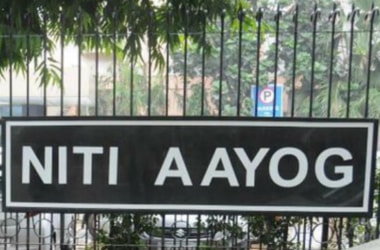 Lakshadweep and Andaman & Nicobar Islands have been identified as tourism growth zones as part of a Niti Aayog masterplan. Lakshadweep and Andaman & Nicobar Islands have been identified as tourism growth zones as part of a Niti Aayog masterplan.
- Nine islands have been selected as the part of the masterplan
- The islands are being seen as drivers of tourism and sustainable economic growth on the lines of countries like Singapore
- Water parks and natural resource will be used to promote tourist initiatives, overcoming limited land areas while being mindful of conservation
- Ecological sensitivity of the islands will also be taken into account while improving options for tourists
- Options in Lakshadweep which sees high end tourism are limited compared to A&N islands
- Andaman and Nicobar islands identified as part of the masterplan were Smith Island, Avis Island and Long Island
- Slotted for development in Lakshadweep are Bangaram, Thinnakara, Suheli, Cheriyam and Minicoy
- Tourist facilities in Lakshadweep are currently limited to Bangaram and a few other islands
- Inclusion of Little Andaman, the biggest island in the chain with area of 734.34 square km was discussed in detail
- It is roughly the size of Singapore
- Singapore has earmarked 10 percent of its area for parks/natural resources and ranks fourth globally in the environment performance index
- 90 percent of Andaman and Nicobar islands are notified as reserved or deemed forest; only 6 percent of the land is available for development.
- Plan gained momentum after the islands were selected for tourism, agriculture and infrastructure as well as renewable energy development
|
▼ India slips to 112th on World Economic Freedom Index [09-22-16]
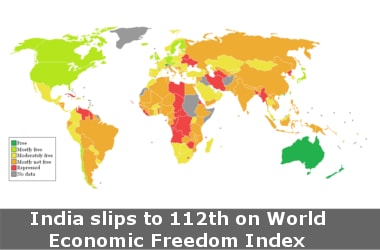 India slipped by 10 ranks to 112th in a list of 159 countries and territories. India slipped by 10 ranks to 112th in a list of 159 countries and territories.
- It fared badly in all categories including legal system and regulation according to the Economic Freedom of the World; 2016 Annual Report
- THe report say China, Bangladesh and Pakistan ranking back at 113, 121 and 133
- Bhutan, Nepal and Sri Lanka fared better
- India fared badly in legal system and property rights (86) sound money policies (130) freedom for global trade (144) and regulation(132)
- Except for size of government where it fared better (8) a negative performance was evident across the index
- Report is based on 2014 data and measures economic freedom by analysing policies and institutions of the countries and territories studied
- The report uses 42 distinct variables, from for example the World Bank, to measure this. Some examples: tax rates, degree of juridical independence, inflation rates, costs of importing, and regulated prices.
- Each of the 5 areas above is given equal weight in the final score.
The cornerstones of economic freedom are:
- Personal choice rather than collective choice;
- Voluntary exchange coordinated by markets rather than allocation via the political process;
- Freedom to enter and compete in markets; and
- Protection of persons and their property from aggression by others
In practice, the index measures:
- Size of Government;
- Expenditures, Taxes, and Enterprises;
- Legal Structure and Security of Property Rights;
- Access to Sound Money;
- Freedom to Trade Internationally; and
- Regulation of Credit, Labor, and Business.
|
▼ Government launches flexi funds for CSS [09-13-16]
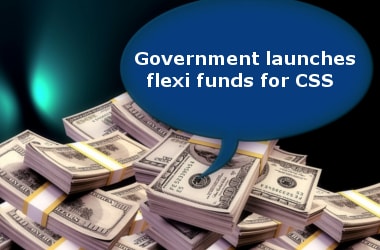 Government has issued fresh flexi fund guidelines that provide more freedom to states for spending money under the Centrally Sponsored Schemes to meet local developmental requirements. Government has issued fresh flexi fund guidelines that provide more freedom to states for spending money under the Centrally Sponsored Schemes to meet local developmental requirements.
- As per the new norms, flexi funds in each CSS has been increased from 10 to 25 percent for states and 30 percent for UTs
- States can use the fund to undertake mitigation or restoration activities in case of natural calamities or to satisfy local requirements in areas affected by internal security disturbances.
- State governments will constitute state level sanctioning committee to avail of this fund
- This fund facility is not for CSS which emanate from legislation like MNREGA
- Subgroup of CMs in consultation with the stakeholders had earlier supported rationalisation of CSS
|
▼ Union Cabinet approves the formation of GST Council [09-13-16]
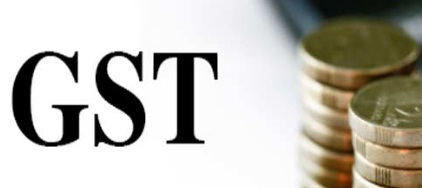 Union Cabinet on 12th September 2016 approved the process, formation and functioning of the Goods and Services Tax Council Union Cabinet on 12th September 2016 approved the process, formation and functioning of the Goods and Services Tax Council
- Council will comprise FM and state Finance Ministers making recommendations on important issues pertaining to GST including items and rates
- Creation of the GST Council is as per A279A of the amended Constitution
- Creation of the GST Council Secretariat took place with its office in New Delhi
- Appointment of the Secretary (Revenue) as the Ex Officio Secretary to the GST Council also took place
- Chairpersons were included while CBEC was a permanent invitee (non-voting) on all proceedings of the GST Council
- A post of additional secretary to the GST Council in the GST Council Secretariat and 4 posts of Commissioner in the GST Council Secretariat was also approved
- As per Article 279A of the amended Constitution, GST Council shall comprise the following members:
- Union Finance Minister- Chairperson
- Member: Union Minister of State in Charge of Revenue of Finance
- Members: Minister in charge of finance or taxation or any other minister nominated by the state government
- On September 8, 2016 President Pranab Mukherjee have assent to the 122nd Constitutional Amendment Bill paving the way for the rollout of GST
- The new tax regime will do away with indirect taxes ushering in one tax for the entire country
- Around 18 states have ratified the bill
- GST is a single indirect tax which will subsume most of the central and state taxes as VAT, excise duty, service tax and CST
|
▼ G-20 pledges to remove protectionism [09-6-16]
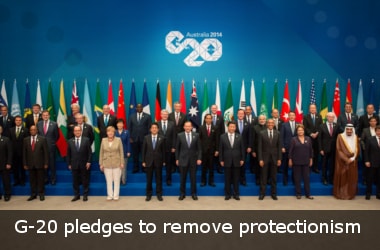 G-20 nations pledged to roll back protectionist measures by end of 2018 and ensure rule based, transparent multilateral trading system with WTO for global growth. G-20 nations pledged to roll back protectionist measures by end of 2018 and ensure rule based, transparent multilateral trading system with WTO for global growth.
- The group of 20 nations also reaffirmed to continue to support the world of WTO, UNCTAD and OECD in monitoring protectionism
- Emphasising the benefits trade and open markets must be communicated to the wider public more effectively and accompanied by domestic policies to ensure benefits are widely distributed.
- Leaders also committed to ratify the Trade Facilitation Agreement towards the close of 2016 and called for other WTO members to do the same.
- They also reiterated advancing negotiations on remaining Doha Development Agenda issue as a matter of priority including three pillars of agriculture-market access, domestic support and export competition, non agricultural market access and services among others.
- The nations also recognised the need to ensure consistency with WTO rules.
- Leaders also endorsed the strategy for global trade growth under which the G20 will lead by example to lower trade costs, harness trade and investment policy coherence boost trade in service, enhance trade finance and promote e-commerce development and address trade and development .
- It also added that the G-20 will continue to prioritise the work on food security, nutrition, sustainable agricultural growth and rural development as a significant contribution to implementing the 2030 Agenda for Sustainable Development
- The G-20 also reaffirmed its commitment to promoting investment with focus on infrastructure in terms of both quantity and quality
- It would also support policies that encourage firms of all sizes in particular women and young entrepreneurs, women led firms and SMEs to take advantage of global value chains.
- Further it said generating quality employment is indispensable for sustainable development and is at the centre of the domestic and global agenda of the G-20.
- The communique also stressed it will further develop G-20 employment plans in 2017 to address these commitments and monitor progress in a systematic and transparent manner in attaining the G-20 goals especially on youth employment and female labour participation
|
| Chronology of events |
|
Telangana signed an MoU to help Goa in IT development through T-Hub, India’s largest incubator for startups in Hyderabad
|
|
Market regulator SEBI made Unique Client Code/UCC and Permanent Account Number/PAN mandatory for persons transacting on commodity exchanges.
|
|
World Economic Freedom Index ranked India at 112
|
|
Asian Development Bank in September 2016 approved 631 million US dollars loan for- Visakhapatnam-Chennai industrial corridor
|
|
CCEA approved the partial capital grant of 5176 crore rupees for development of 2539 km long Jagdishpur-Haidia and Bokaro-Dhamra Gas Pipeline (JHBDPL) project to GAIL (India) Limited
|
|
India ranked 39 in the Global Competitiveness Report 2016-2017 of the World Economic Forum
|
|
Hindustan Cables Limited closure was approved by the Union Cabinet w.e.f 29th Sept 2016.
|